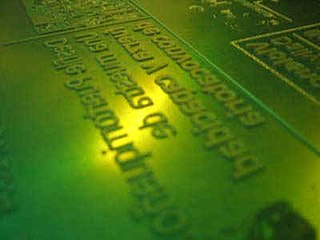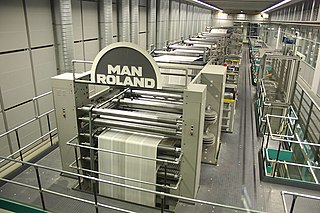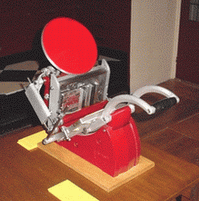
Lithography is a planographic method of printing originally based on the immiscibility of oil and water. The printing is from a stone or a metal plate with a smooth surface. It was invented in 1796 by the German author and actor Alois Senefelder and was initially used mostly for musical scores and maps. Lithography can be used to print text or images onto paper or other suitable material. A lithograph is something printed by lithography, but this term is only used for fine art prints and some other, mostly older, types of printed matter, not for those made by modern commercial lithography.

A printing press is a mechanical device for applying pressure to an inked surface resting upon a print medium, thereby transferring the ink. It marked a dramatic improvement on earlier printing methods in which the cloth, paper, or other medium was brushed or rubbed repeatedly to achieve the transfer of ink and accelerated the process. Typically used for texts, the invention and global spread of the printing press was one of the most influential events in the second millennium.

Printmaking is the process of creating artworks by printing, normally on paper, but also on fabric, wood, metal, and other surfaces. "Traditional printmaking" normally covers only the process of creating prints using a hand processed technique, rather than a photographic reproduction of a visual artwork which would be printed using an electronic machine ; however, there is some cross-over between traditional and digital printmaking, including risograph.

Printing is a process for mass reproducing text and images using a master form or template. The earliest non-paper products involving printing include cylinder seals and objects such as the Cyrus Cylinder and the Cylinders of Nabonidus. The earliest known form of printing evolved from ink rubbings made on paper or cloth from texts on stone tablets, used during the sixth century. Printing by pressing an inked image onto paper appeared later that century. Later developments in printing technology include the movable type invented by Bi Sheng around 1040 AD and the printing press invented by Johannes Gutenberg in the 15th century. The technology of printing played a key role in the development of the Renaissance and the Scientific Revolution and laid the material basis for the modern knowledge-based economy and the spread of learning to the masses.
Duplicating machines were the predecessors of modern document-reproduction technology. They have now been replaced by digital duplicators, scanners, laser printers and photocopiers, but for many years they were the primary means of reproducing documents for limited-run distribution. The duplicator was pioneered by Thomas Edison and David Gestetner, with Gestetner dominating the market up until the late 1990s.

Flexography is a form of printing process which utilizes a flexible relief plate. It is essentially a modern version of letterpress, evolved with high speed rotary functionality, which can be used for printing on almost any type of substrate, including plastic, metallic films, cellophane, and paper. It is widely used for printing on the non-porous substrates required for various types of food packaging.

A rotary printing press is a printing press in which the images to be printed are curved around a cylinder. Printing can be done on various substrates, including paper, cardboard, and plastic. Substrates can be sheet feed or unwound on a continuous roll through the press to be printed and further modified if required. Printing presses that use continuous rolls are sometimes referred to as "web presses".

Offset printing is a common printing technique in which the inked image is transferred from a plate to a rubber blanket and then to the printing surface. When used in combination with the lithographic process, which is based on the repulsion of oil and water, the offset technique employs a flat (planographic) image carrier. Ink rollers transfer ink to the image areas of the image carrier, while a water roller applies a water-based film to the non-image areas.

Letterpress printing is a technique of relief printing for producing many copies by repeated direct impression of an inked, raised surface against individual sheets of paper or a continuous roll of paper. A worker composes and locks movable type into the "bed" or "chase" of a press, inks it, and presses paper against it to transfer the ink from the type, which creates an impression on the paper.

Rotogravure is a type of intaglio printing process, which involves engraving the image onto an image carrier. In gravure printing, the image is engraved onto a cylinder because, like offset printing and flexography, it uses a rotary printing press.
Tympan means skin, and is used in a variety of technical meanings.
A platen is a flat platform with a variety of roles in printing or manufacturing. It can be a flat metal plate pressed against a medium to cause an impression in letterpress printing. Platen may also refer to a typewriter roller which friction-feeds paper into position below the typebars or print head. It can refer to the glass surface of a copier, and the rotating disk used to polish semiconductor wafers.

Robert Smail's Printing Works is a fully functional Victorian era letterpress printing works in the small Scottish Borders town of Innerleithen, now preserved by The National Trust for Scotland as an Industrial Heritage museum showing visitors the operation of a local printer around 1900 while still carrying out orders for printing and stationery.
In printing, set-off is the term given to the unwanted transfer of ink from one printed sheet to another. The problem can occur with most types of printing, and is avoided by the use of slipsheets between copies or anti-set-off spray powder.

Heidelberger Druckmaschinen AG is a German precision mechanical engineering company with registered offices in Heidelberg (Baden-Württemberg) and headquarters in Wiesloch/Walldorf (Baden-Württemberg). The company offers product and services along the entire process and value chain for printing products and is the largest global manufacturer of offset printing presses. Sheet-fed offset printing is used predominantly for high-quality, multi-colour products, such as catalogues, calendars, posters, and labels. Heidelberg produces equipment for prepress, press and postpress.

A jobbing press, job press, or jobber is a variety of printing press used in letterpress printing.

Adana Printing Machines were manufactured from 1922 to 1999 in Twickenham, England. Although most of the printing presses produced by Adana were aimed at hobby printers, they were frequently put to commercial use. Adanas are still to be found throughout the world in the hands of colleges, enthusiasts and professional printers. Caslon Limited manufactured machines after a takeover of the company in 1987.

The Ben Lane Print Shop is a demonstration site at Shelburne Museum in Shelburne, Vermont, in the United States.

Harrild & Sons Limited is a defunct British manufacturer of printing machinery and supplies. The company was founded in 1809 by Robert Harrild at Norwich Street, London, and closed down in 1949. The company helped to establish the use in London of composition rollers instead of ink balls to ink the printing plates.

The Ruthven printing press was invented and manufactured by John Ruthven of Edinburgh, Scotland, from 1819 to 1822. The Ruthven press was an iron bed press which functioned by means of an unconventional platen which rolled over a stationary table which held the type, where the pressure on the type faces was exerted from below, instead of in the conventional method where pressure was applied from above. The platen is supported by two iron springs, under which are four brass bevelled wheels which move along on two tracks made of bevelled steel. After the impression is made the springs give way, and consequently rise up. The press overall incorporated a number of other rather complex mechanical components, the details of which are beyond the scope of this article. The press was smaller in size than most presses of this period, easier to use, and subsequently it quickly established a favorable reputation for itself among English printers.
















